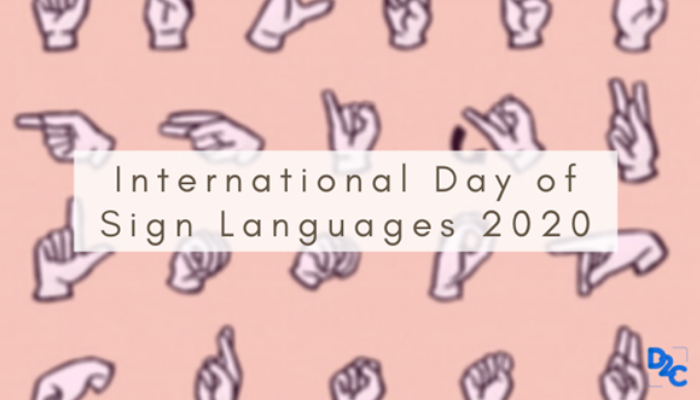Discussing the importance of sign language on International Day of Sign Languages 2020

The theme for the International Day of Sign Languages 2020 is "Sign Languages Are for Everyone!" With this theme, the day aims to spread awareness that everyone should learn sign language, especially since it has been accorded equal status in comparison to spoken languages. In India itself, there are 1.8 million native speakers of sign language, but only 250 certified sign language interpreters, making the language the need of the hour. To honour International Day of Sign Languages, let us explore the history and importance of the wonderful language.
Every year on September 23, the world observes International Day of Sign Languages to acknowledge early access to sign language and various services in sign language like quality education which is vital to the development and growth of the deaf individual. This day was first celebrated in 2018 and September 23 was chosen as a specific date because the World Federation of the Deaf (WFD), established in 1951, is also celebrated on the same day.
According to the World Federation of the Deaf, there are 70 million people in the world who use sign language to communicate. It is the only medium through which the deaf people communicate their feelings and emotions. On the occasion of International Day of Sign Languages, let us understand the history behind the language, and why you should learn it too.
History and significance of sign language
The International Day of Sign Languages highlights the importance of the language, in contrast to the rich history it shares. You would be surprised to know that the first recorded mention of sign language goes back to ancient Greece, making it one of the oldest, and the most important languages in the world!
In the fifth century B.C., the philosopher Plato wrote the dialogue Cratylus. In it, he recorded Socrates saying, “If we had neither voice nor tongue, and yet wished to manifest things to one another, should we not, like those which are at present mute, endeavour to signify our meaning by our hands, head, and other parts of the body?” Apparently ancient Greeks who couldn’t speak did indeed have a rudimentary sign language to go about their daily lives.
As early as the 11th century, monks developed basic gestures to aid with essential communication during a vow of silence. In the 1500s, Pedro Ponce de Leon, a Spanish Benedictine monk, adapted these signs to help educate deaf students in Spain. He is the first recognized teacher of the deaf and his work paved the way for the creation and instruction of a formal sign language.
Even though the early steps in creating an official language for the deaf were taken in Spain, the first formal sign language was actually developed in France. Charles Michel de l'Eppe, a French priest, established the original public school for deaf children, the Institution Nationale des Sourds-Muets à Paris (National Institute for Deaf-Mutes in Paris) in 1755. This was the first systematic and organized approach to the education of the deaf and it led to l'Epee being referred to as the 'Father of the Deaf.' This standardized sign language is now referred to as Old French Sign Language and quickly spread across Europe and to the United States.
To sum it up, sign language has had a rich history. The occasion of the International Day of Sign Languages raises awareness about not only how the expressive language was developed, but also of its significance. As a medium which helps give a voice to people who cannot speak, the intricate language carries a lot of weight.
Why should you learn sign language?
As someone who is gifted with the ability to hear and speak, you may ask why you should learn sign language. The International Day of Sign Languages takes into consideration the genuine doubt, and with this year’s theme of “Sign Languages Are For Everyone!”, it has raised awareness on why you should pick up the versatile language:
1. Helps you communicate with everyone
With this year’s theme for International Day of Sign Languages, the WFD wants you to realise the importance of the language, and how it is inclusive of everybody. Learning the skill of sign language shows the deaf community that they are not being forgotten and that they have the same access to communication with the rest of the world as anyone else.
After all, everyone has the right to be heard and express themselves. No one should be left out.
2. Advantages over spoken languages
The United Nations International Day of Sign Languages 2020 mentions how the language is “...structurally distinct from the spoken languages.” It boasts numerous advantages and can be used when the spoken word is physically impossible, such as talking underwater, talking through glass, from a distance, at a loud music concert, and talking with your mouth full. Sign languages can also let you talk to someone without interrupting others with noise.
3. Long-term cognitive benefits
A scientific advantage behind learning sign language is the cognitive benefits it carries. According to a 20-year longitudinal study conducted by California State University, early exposure to sign language leads to heightened reasoning skills and raises a child’s IQ by an average of 12 points. Who knew learning a new language could keep your brain sharp!
4. Improves expressive communication and body language
In order to encourage everyone on International Day of Sign Languages to learn the dynamic language, the WFD emphasises on the development of non-verbal cues. When you sign, you not only express the words but feelings too. Moreover, a study showed that people who use sign language have an improved ability to read body language.
5. Easy to learn
Sign language is not as complex as it seems to be. So many of the signs are commonplace gestures. Children pick up on the signs quickly and are eager to use them. The fact that it is easy, helps encourage the learning, and makes it a wonderful advantage.
The biggest advantage of them all is that the rewards of this language are immeasurable. It is a simple step to inculcate awareness and sensitivity within yourself towards the community. Moreover, statistics shown on International Day of Sign Languages 2020 have indicated that the popularity of the language is growing day by day, making it a good choice to learn the language.
How can you learn sign language?
The International Day of Sign Languages is working to spread awareness about the ease with which anyone can learn the wonderful language. There are numerous resources you can use to learn sign language:
1. YouTube tutorials
YouTube is a blessing in disguise with free access to videos on how you can learn sign language. You just have to type the language you wish to learn (keep in mind that there are different languages with the world of sign language) and enter! If you wish to learn Indian Sign Language (ISL) check out, “E-Gyaanshaala”. “Expert Village” is a great page for beginners who wish to learn American Sign Language (ASL).
2. Online courses
The International Day of Sign Languages has encouraged several websites to provide free online courses for sign language. Websites like Sign Language 101 provide free courses for beginners to sharpen their ASL.
3. Apps
Since most of us are on our phones for the majority of the day, why not make good use of it by downloading an app which can teach you sign language? There are thousands of apps on the store you can download with a touch of the button. Oscar-winning deaf actress Marlee Matlin has her own app which teaches ASL for free named “Marlee Signs”.
Let us take the International Day of Sign Languages as an opportunity to learn a language which not only has a rich history but carries numerous advantages for its speakers. So take the initiative to learn the beautiful language today!
If you are interested in the world of languages and wish to learn a new one, then check out the following links:
Login to continue reading
And access exclusive content, personalized recommendations, and career-boosting opportunities.
















Comments
Add comment